Menu
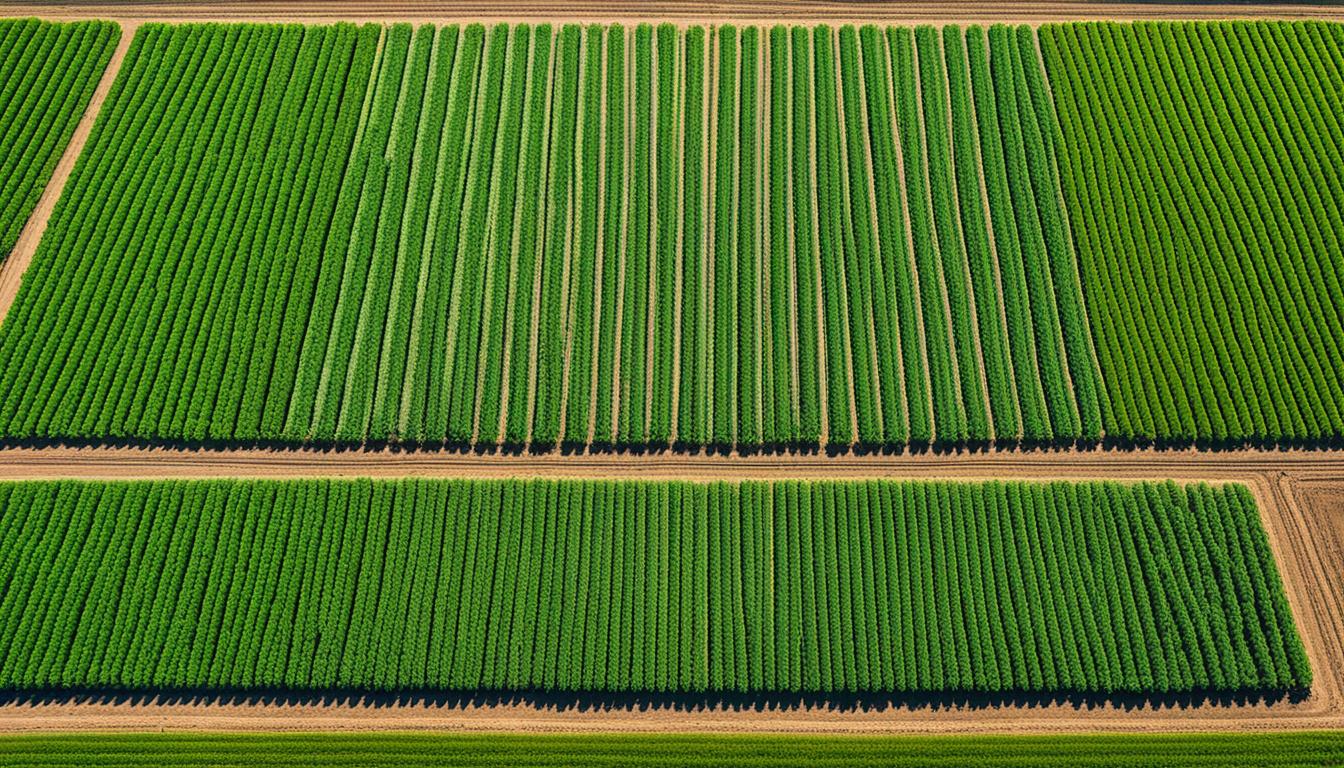
Did you know precision planting techniques can make crops up to 20% more productive? This big increase shows how powerful precision agriculture can be. It changes the way we farm in a big way. With advanced technology, precision planting meets the exact needs of plants and soil. This helps them grow better and more efficiently.
The market for precision planting is growing quickly. It’s fuelled by new technology and more people realising its benefits. While precise planting can lead to better crop yields and help save resources, not everyone uses it. Developing countries might be slower at picking it up. But groups like the FAO are working to spread the word. They aim to educate people about these new farming technologies.
The mix of high-tech sensors, data analysis, and quick decision-making is changing how we manage farms. It aims to get the most out of every crop. Today, precise planting methods are at the core of modern and sustainable farming. As the world faces more food needs and climate problems, using precise planting is becoming crucial.
Precision agriculture has changed farming in the last few decades. It focuses on planting seeds exactly right to get more crops and protect nature.
This way of farming started over 50 years ago, in the 1960s. Farmers began planting their crops in a pattern, like squares, to use their land more efficiently.
Today, precision farming is very popular, thanks to fast computers and new tech. It uses these tools to grow more food while using fewer resources.
Climate change and the need for more food make precise planting vital. It helps meet global goals for sustainable farming.
Now, farmers use GPS and sensors to plant seeds precisely, even without ploughing. This lets them grow different crops in the best way possible.
Farming used to rely on what farmers could see and learn. But now, with data, they can get advice tailored to their fields. Dutch farmers have shown great results using this new approach, and more is yet to come.
New tools like drones and satellites watch over fields. They check on the weather and how crops are doing. This data helps make smart farming decisions.
Starting with precision farming needs money for tools and learning. But, in the long run, it pays off by making fields more productive. This way, farmers can grow more food using less land.
Firms like Vista and ABACO Group in Europe lead in this field. They offer new technologies that save water, land, and time.
Agricultural technology plays a key role in modern farming, especially precision planting. It uses advanced tools like sensors for better crop growth and less waste. These tools help farmers plan their fields better through custom strategies. This boosts crop quality and helps the environment.
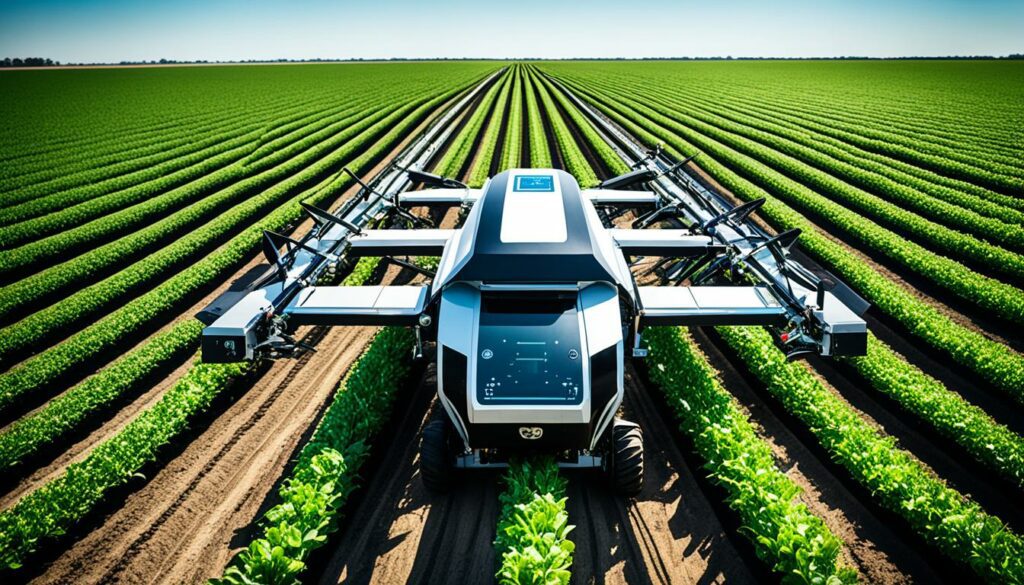
Advanced sensors are at the heart of precision farming, giving detailed insights for each area of a field. They help farmers adjust fertiliser use and manage machinery smarter. By doing this, the need for harmful chemicals goes down. It also helps save money and increase farm yields over time.
Variable Rate Technology (VRT) is key. It uses up-to-date information to apply just the right amount of resources. This makes farming more efficient and the soil healthier. GPS and satellite tech also play a role. They help with figuring out when crops are ready, using special maps and data.
GPS and GNSS tech have changed farming for the better. They provide accurate location details for better farming practices. This allows for precise mapping of fields and setting up systems for better planting.
UAVs or drones with GPS are also very helpful. They can see things like watering needs and crop health from above. This helps farmers react quickly to problems in the fields. It’s all part of a new way of farming that’s more efficient and better for the land.
This mix of high-tech tools is transforming farming. By combining sensors, analytics, GPS, and more, farmers can grow better crops using fewer resources. This means smarter, more sustainable farming.
Precision planting offers many benefits. With automated planting, farmers can place seeds accurately. This results in crops growing evenly, which boosts productivity. Advanced tech ensures seeds are evenly spaced, saving resources and aiding plant growth.
This method boosts both growth and saves money. Using technology like GPS, farmers make smart choices. This cuts down costs on water, seeds, and fuel. Automated systems also make planting easier, dropping work costs and making the farm more efficient.
There are big wins for the planet too. Precision planting cuts back on resource waste. It ensures seeds are only used where needed, which cuts down on water and fertilisers. This is good for the soil and lessens reliance on the weather.
Using drones and satellites gives farmers up-to-the-minute info on their crops. This means they can act swiftly and smartly to improve crop yield. Crop yield optimisation is the direct result of these high-tech farming solutions.
By supporting this new way to farm, we’re making a lasting impact. We’re helping farmers do more while taking good care of the land. This is improving farming’s success and profitability.
Getting the seed spacing right is critical for farming success. It’s a big part of precision planting. It ensures each crop gets the space it needs to grow well and take in nutrients effectively. The US grows soybeans on about 82 million acres a year, making perfect seed spacing key for top yields.
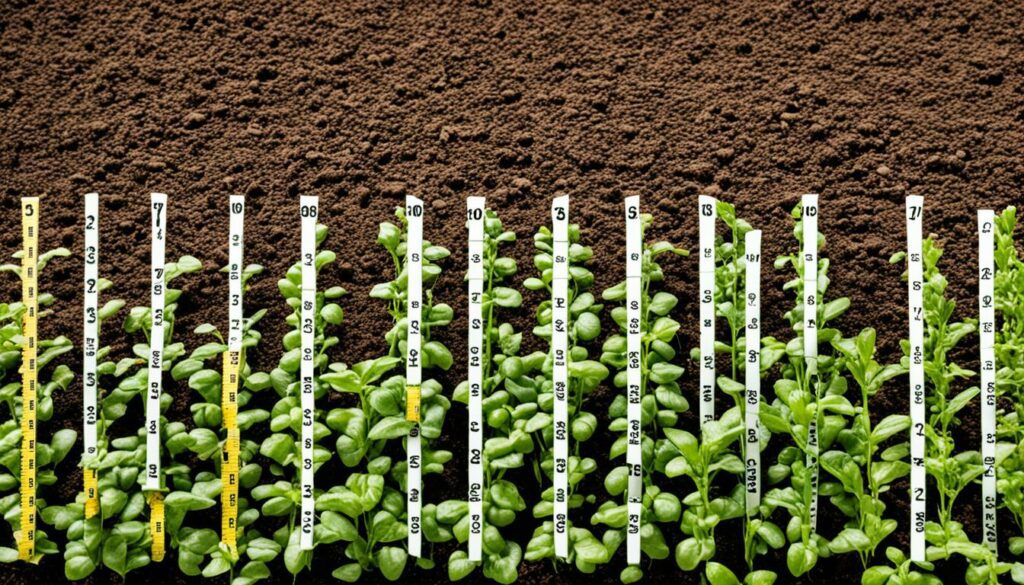
Plants need their own space to grow properly and not compete too much. If they’re too close, they fight over sunlight, water, and nutrients. This can hurt how much we harvest and the overall health of the plants. Using precise methods to place seeds avoids this. It makes plants grow more evenly and healthy.
Studies show that at a low planting rate of 40,000 seeds per acre, precise planting made a big difference. With less than 3,500 extra plants per acre – grown because of more reliable spacing – there was a 12-bushel per acre increase. This is a clear win for optimising plant population and maximising nutrient uptake.
Good seed spacing also means crops can get more nutrients from the soil. This helps them grow better and produce more. By placing seeds at the right intervals, each plant can get the nutrients it needs. This results in healthier plants and a more productive crop overall.
In fact, research highlights that at 40,000 seeds per acre, precise planting significantly boosted seed yield. It achieved this with about 3,500 fewer plants per acre, thanks to better spacing. So, getting the seed spacing correct does more than just manage plant numbers. It truly makes a difference in how well crops grow by allowing them to take in more nutrients.
Getting the right planting depth is key for seeds to grow well. Farmers use special tools to plant seeds just right. This helps all seeds grow at the same rate and become strong plants.
If seeds aren’t planted correctly, a lot of plants can get hurt. Usually, every 17.5 feet, one plant isn’t doing well. This can cause a big loss in the harvest. For example, if plants are started slightly late, the farm might lose a lot of money. This small delay could mean losing $2,100 on a large piece of land growing corn.
It’s also important to make sure the seed touches the soil well. The right amount of moisture is important for germination. Experts say the best moisture level is at least 30%. If there’s not enough moisture, the seeds might get sick, and this stops them from growing.
SmartDepth is one example of cool technology that helps farmers seed right. It lets them change the planting depth very accurately while sitting in their tractor. The FurrowForce system also helps by making sure the soil on top of the seeds is just right.
Other tools like SmartFirmer and Reveal help farmers plant better. They make a clear improvement by making sure the seeds go in the ground just right. This improvement adds up to a bigger, better crop.
| Technology | Benefit |
|---|---|
| SmartDepth | Precise depth adjustments in 1/10th inch increments |
| SmartFirmer with Reveal | +2.9% increase in Clean Furrow value |
| Reveal frame-mounted row cleaner | +5.6% improvement in Good Ride |
Using precise methods to plant has a big impact. It makes sure seeds grow into good plants. This is important for a better harvest and more money for the farmer.
Automated planting systems are changing modern farming in a big way. They bring precision and efficiency to farming fields. Through exact seed delivery, they cut down on mistakes.
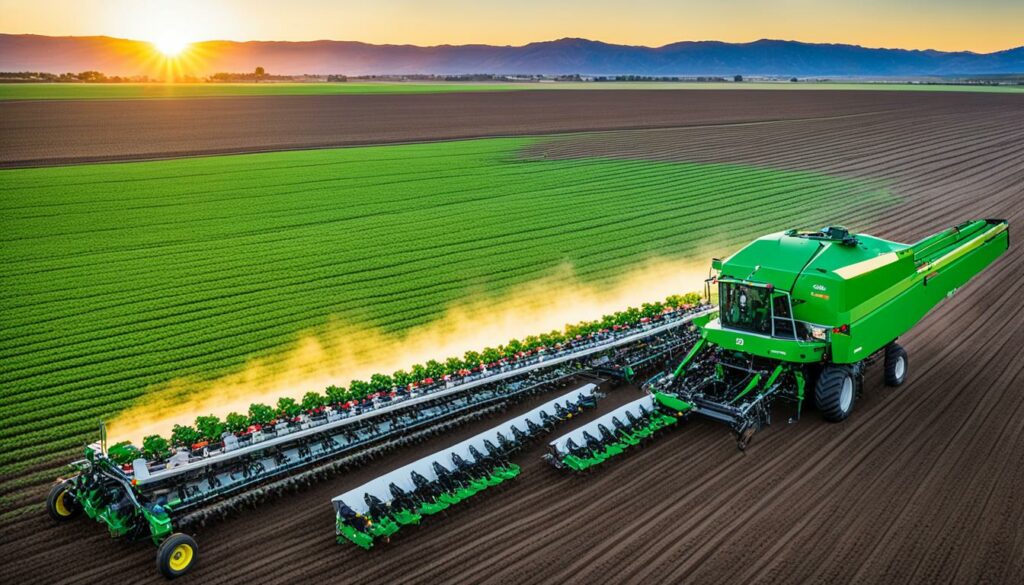
Automated planting stands out for its precise work. It uses advanced GPS and machine learning. This ensures seeds go in at the best depths and intervals.
Thanks to this, crops grow evenly and there’s more to harvest. With autonomous farming, tasks get done with almost perfect accuracy. This makes farms more efficient.
These systems also make farming less labour intensive. They work day and night without people having to watch them. This means farmers can do more with less effort.
They help tackle not having enough workers. This way, farmers can use many machines at once. This boosts how much they grow and the quality of their crops.
So, automated planting is reshaping farming. It cuts costs and raises how much farmers can produce. It does all this while being good for the environment. It’s a huge step forward for farming.
Getting the soil ready is crucial in precision farming. It’s all about making the perfect bed for seeds to grow. We focus on making sure the soil is airy, full of nutrients, and can keep the right amount of water.
In Nebraska, a recent study found something intriguing. It showed that taking samples very close together (up to 42 samples per acre) gives a good look at the soil’s nutrients everywhere. The nutrients in the soil can really change how well plants grow and produce.
Planting perfectly means making sure the machines put seeds at the best depth and distance apart. This helps the plants grow well and use nutrients from the soil correctly. In Lincoln County, using different methods to sample fields led to varied suggestions for nitrogen, differing in 45% of the field.
Taking one sample per acre is best practice, with samples from five spots close to each other. This method gives you detailed nutrient maps that stay useful for many years. And it’s good to remember to check on important nutrients like phosphorus every five years.
It’s also important to do tests based on several pieces of information. Testing with four to six sections in a field keeps the areas to manage from being too small. This way, farmers can treat their fields more evenly, and see better results.
The table below shows some important points about preparing soil:
| Aspect | Details |
|---|---|
| Grid Sampling | 42 samples per acre show true variability |
| Nitrogen Recommendations | 45% variability with wider grids |
| Sampling Density | 1 sample per acre helps make accurate maps |
| Phosphorus Sampling | Check every 5 years |
| Directed Sampling | Use 4-6 sections to prevent too much division |
Yield maps change a lot based on soil conditions. Things like how compact the soil is and how deep the topsoil goes are key. Also, things like disease and weeds really matter. Getting the soil ready right helps calibrate planting tools well. This leads to better crops and more effective farming.
The calibration of planting equipment is key to good farming. It needs proper care and exact tweaks to work well. If not, it can harm the harvest. To get seeds right, you must use the best tools and techniques.
To keep planting even, you must check seed depth, space, and how seeds touch the soil. This evens out different soil types. It makes sure the planter works as best as it can. Checking seed settings constantly helps reach the best harvest possible.
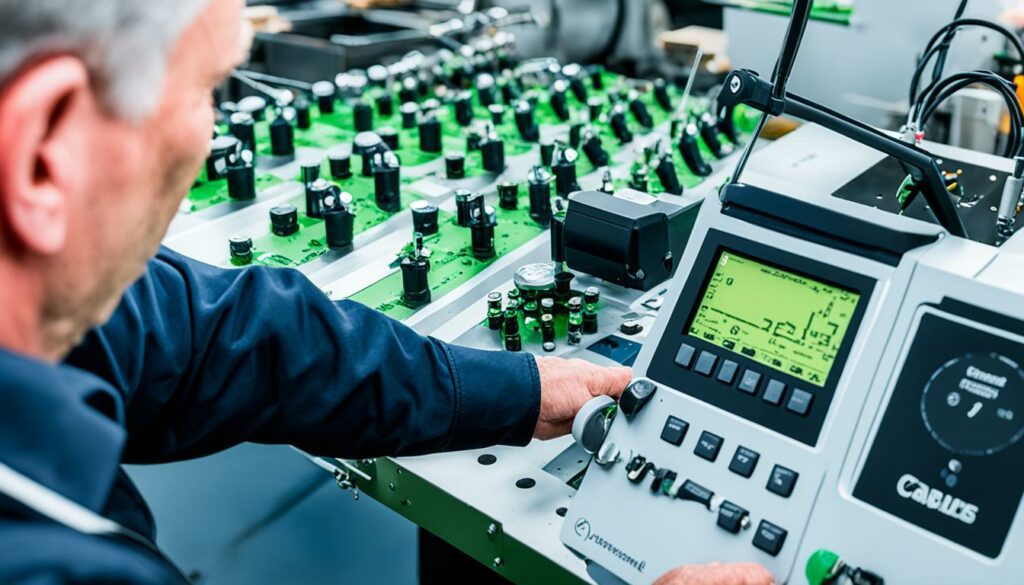
To stay on top shape, you need to make some tweaks. Adjusting the seed-opener, depth wheels, and the closing system is crucial. This ensures the seeds go as deep as needed and touch the soil well, just right to avoid hardening.
The right tools and ways can make calibration work like a charm. In growing soybeans, using a rotary hoe after weeds start can boost their health. And don’t forget to keep your spray gear in check. Change nozzles if they’re over 10% worn to stop mistakes.
What you do in the next few weeks really matters. It affects your crop, money, and the land. So, being careful with your tools and setting them just right is super important. It’s key to looking after your resources and keeping the farm going strong.
Precision planting is key to cutting down on agriculture’s harm on the environment. It adds value by using fewer resources like water and fertilisers. With this approach, farmers can produce 4% more crops. Also, they get better at using resources wisely.
This method boosts the way fertiliser is laid, raising efficiency by 7%. This means less fertiliser is used. As a result, water pollution decreases. Also, 9% fewer herbicides and pesticides are used. This cuts down harm from these chemicals.
By applying precision planting, there’s a 6% drop in using fossil fuels. This is like saving 100 million gallons of fuel. It also helps decrease water use by 4%. Enough water is saved to fill 750,000 Olympic pools.
With the adoption of precision planting, we avoid using over 2 million acres of cropland, thanks to more efficient land use.
See the table below for how precision planting impacts the environment in a good way:
| Impact | Percentage Reduction | Quantifiable Benefit |
|---|---|---|
| Crop Production | 4% increase | – |
| Fertiliser Placement Efficiency | 7% increase | – |
| Herbicide and Pesticide Use | 9% reduction | 30 million fewer pounds used |
| Fossil Fuel Use | 6% reduction | 100 million fewer gallons used |
| Water Use | 4% reduction | Equivalent to 750,000 Olympic-size swimming pools saved |
Using all precision agriculture technologies entirely could offer more gains. It might cut down water usage by 21% and reduce fossil fuels by 16%. Precision planting is crucial in moving towards sustainable farming. It shows how important it is in lessening our environmental impact.
Precision planting techniques are changing how we farm all over the world. By looking at how they’re used and the benefits, we learn a lot about making agriculture better.
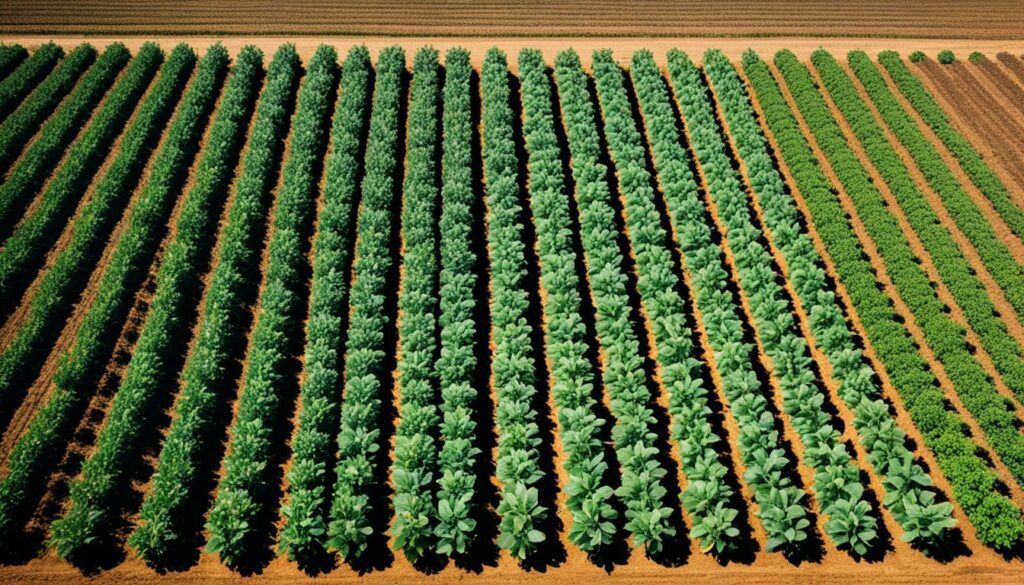
Many factors affect how quickly farmers adopt precision planting. Notably, decisions in precision dairy farming are slow because of many concerns (Borchers and Bewley, 2015; Edwards et al., 2015; Eastwood et al., 2016).
Private companies mostly lead the way in making these technologies. This leadership role adds to the worries about using them (Eastwood et al., 2016).
Having good support helps with these worries (Bewley and Russell, 2010; Hoes et al., 2012). But, not all places have the right kind of support, which slows down adoption (Douthwaite et al., 2001; Oreszczyn et al., 2010).
In some cases, not working together well can stop these methods from doing as much good as they could (Jago et al., 2013). So, it’s suggested we focus more on how to help farmers use new tech and support where it’s needed (Hansen, 2015; Schewe and Stuart, 2014).
Some stories are about how well precision planting works. A great one is the work done by Dairy Australia and New Zealand dairy farmers. They used special funding to bring the benefits of precision planting to dairy farms. This work made the farms more productive and eco-friendly. It’s a good example of the private and public sectors working together.
The process of spreading new technology depends on many things, like education and how willing farmers are to take risks (Rogers, 1995; Pannell et al., 2006). Advances in seed spacing and depth control show how these efforts pay off with better harvests and environmental care.
Precision planting is making big changes in farming. It helps farmers use the latest tech, which is good for the environment and for making more money. These success stories prove the benefits of using precision planting techniques wisely.
In the future, precision planting will keep getting better thanks to new technologies. These tech tools are set to change how farming is done. They will make it both more effective and profitable.
John Deere is a key player in this. They use things like data analysis, IoT, and machine learning. This helps farmers make smart choices based on facts. Agmatix, a startup by ICL Group, is also using data analysis. They focus on improving crop qualities by running better field tests and managing crops.
Precision Planting, a part of AGCO, has brought out new products. These products make planting more precise and efficient. Also, thanks to things like satellite images and remote sensors, farmers can check their crops’ health and soil moisture instantly. This allows them to act fast with accurate information.
Tools like soil and crop sensors give constant updates on nutrients and moisture. Farmers can then meet their crops’ needs exactly. Geographic Information Systems (GIS) map out fields in detail, showing things like shapes and how water moves. This makes farming on the land more precise.
Automated machines and robots are changing farming as well. Self-driving tractors use GPS to move through fields without help. These reduce waste and help the environment. Plus, big data helps make better farming plans. It looks at huge sets of farming data to predict future needs and help crops grow better.
Working together is key to the future of smart farming. Big tech companies, scientists, farming experts, and farmers all join hands. Together, they’re pushing forward new ideas in farming. These ideas aim to make sure we have enough food in the world in a way that’s good for the planet.
The market for precision farming is growing fast, expected to reach $9.4 billion. This growth is supported by new drone tech, AI, robots, and IoT solutions. Drones with cameras and sensors can spot problems in crops and water use from far above. This reduces mistakes and helps farmers be more efficient.
The future of precision planting looks bright with advanced AI and IoT. This, along with using more smart machines and following better rules to protect the earth, will change farming a lot. These new ways of farming can do even better than before, making sure we can keep growing food in a way that’s good for the future.
Precision planting has many benefits but also significant hurdles. The top challenges include high technology costs and slow adoption in some areas. To overcome these, we need smart strategies. This is to make sure more people can use and benefit from precision planting.

The biggest challenge in precision planting is the expensive technology. The USDA reports that in 2023, only 27% of U.S. farms used this kind of tech. Starting costs are high, plus you need to pay for software and maintenance. This makes the tech hard for many to afford.
Data sharing and ownership problems make things more complex. Some farmers worry about their privacy if they use these technologies. Also, there isn’t one set of rules for all devices to work together easily.
So, the key is to make technology cheaper and easier to use. Bringing everyone involved together to work as a team helps. We also need to teach farmers how to use these tools effectively.
Adopting precision planting in developing countries has unique challenges. Small farmers may not be able to afford the high-tech devices. Also, they might not know much about these modern farming methods.
To help, the U.S. has invested about $200 million in research. They aim to support better policy and new technology. These include more incentives, clearer cost benefits, and ways to make data work better.
Solutions include more on-the-ground training and affordable tech. We need government help and new distribution methods. This is to make sure everyone knows about and can access these technologies. Solving these problems can boost global agriculture with precision planting.
| Challenge | Proposed Solutions |
|---|---|
| High initial costs | Investment in affordable technologies, monetary support |
| Data privacy concerns | Establishment of data security protocols |
| Lack of technical expertise | Comprehensive training programs |
Our world is heading towards a future where 9 billion people will need enough food by 2050. The World Bank says food production should rise by 70% to keep up. To achieve this, we must use precision planting.
This farming method makes use of high-tech tools. These include sensors, GPS, and drones. Together, these tools allow farmers to plant and care for crops in very precise ways. This can cut costs, save time, and help the environment.
Precision farming can make farming cheaper by needing less pesticides and fertilisers. This is good for the earth. It also stops soil from getting damaged. When farmers know what their land needs, they can grow better crops.
Yet, there are challenges to using precision planting. These include small plots of land, high costs, and not enough support. However, there are ways to tackle these problems. Working together, sharing new, cheaper technology, and educating people can help.
By planting seeds just right, precision planting can lead to better crops. This is not just good for farms. It is also good for the environment. In the end, precision farming represents a big step forward for farming. It makes farming more efficient, sustainable, and safe for our future.
Precision planting puts seeds exactly where they need to be in the soil. This increases crop yields and saves nature. It uses new tech like sensors and GPS for perfect seed placement.
Tech in agriculture, like sensors and GPS, is vital for accurate planting. It helps in using resources efficiently and increasing crop yield. This results in better farming outcomes.
It helps crops grow evenly and uses resources smartly. By placing seeds properly, it makes the best use of land. This leads to more harvest and is good for the earth.
Spacing seeds rightly is crucial for the number of crops that grow and how well they use nutrients. It stops plants from getting too crowded. Each plant gets enough room to grow, which boosts the harvest.
Getting the planting depth right is key to help seeds grow. This method places seeds at the best level in the soil. It makes sure they get enough water to start growing strong.
Automated systems make farming more accurate and save work. They plant the seeds with care and without human mistakes. This makes farming more efficient and up to date.
Good soil prep is about getting machines and soil ready for planting. It makes the soil perfect for seeds by adding air, nutrients, and keeping the water in. This helps the plants to grow well.
Calibrating machines for planting makes sure seeds are put in just right. It adjusts the equipment so that the seeds grow into strong crops. This helps make farming simpler and resource use better.
Precision planting uses less water and fertiliser. This reduces waste and pollution. By applying resources carefully, it protects the planet and supports good farming.
Yes, many stories from around the world show how much precision planting helps. They show farmers increasing their crop and caring for the environment. This is a great way for farmers to tackle challenges.
The future holds more tech for better farming. New tools will collect data and use resources well. Farming will become even more effective and profitable.
Challenges are there, like tech issues and getting used to the new ways in some places. The answer is to train locals, have governments help, and develop affordable tech. These steps will spread precision planting and its benefits wider.